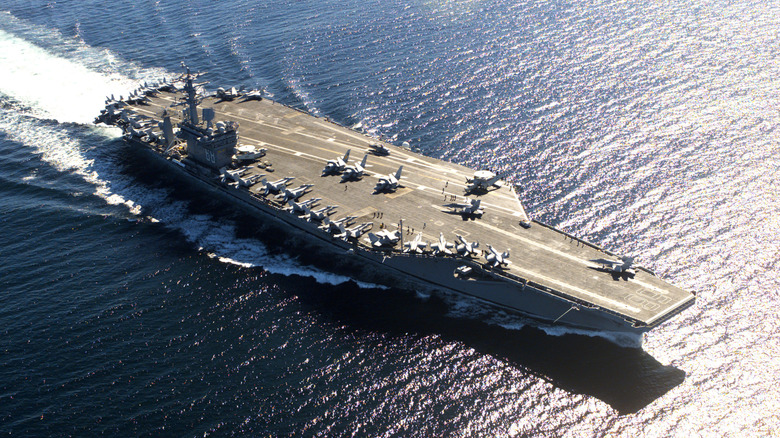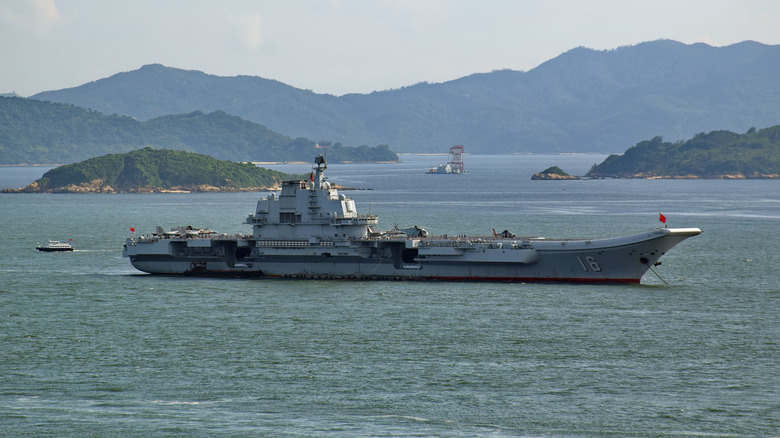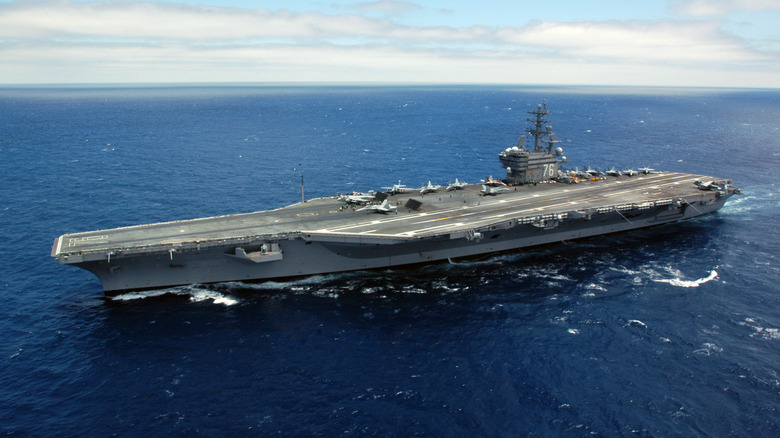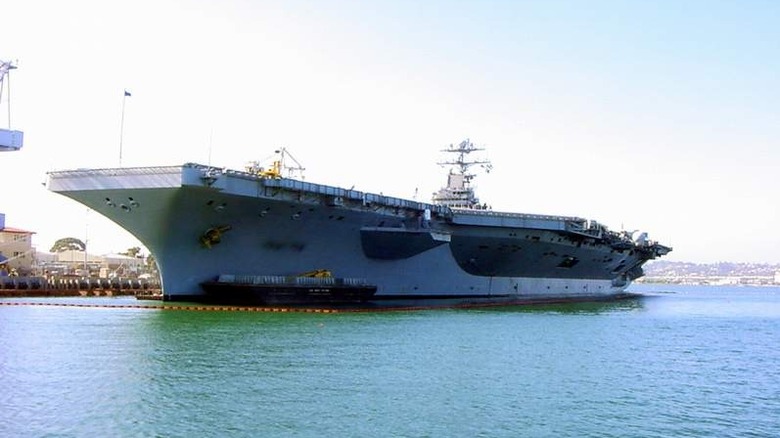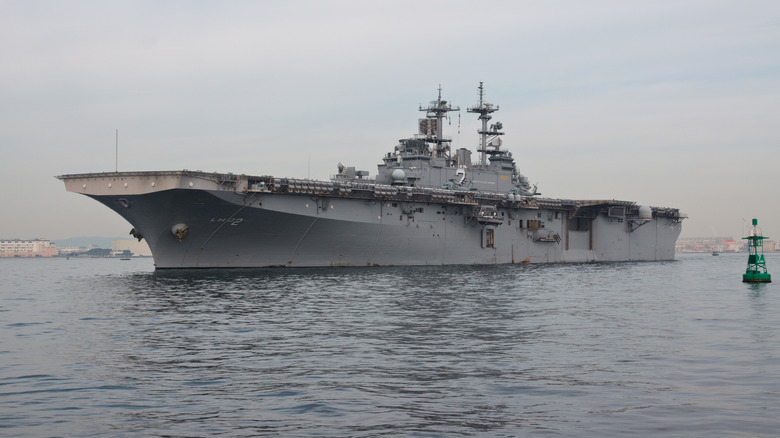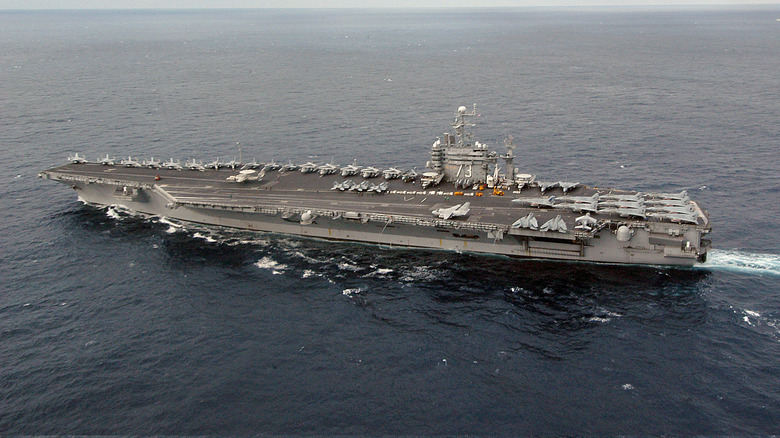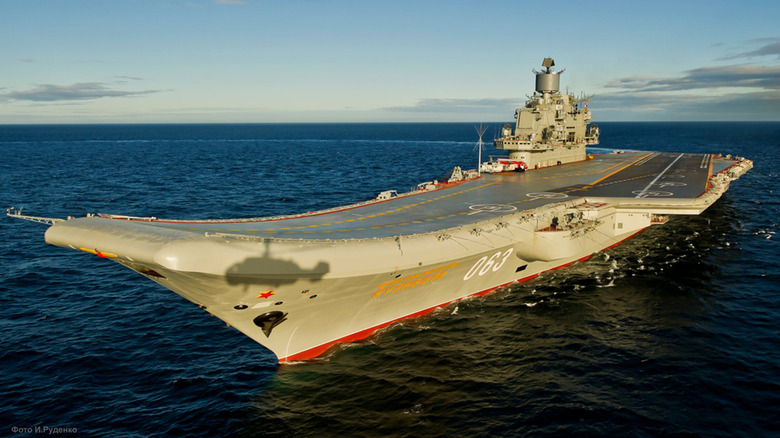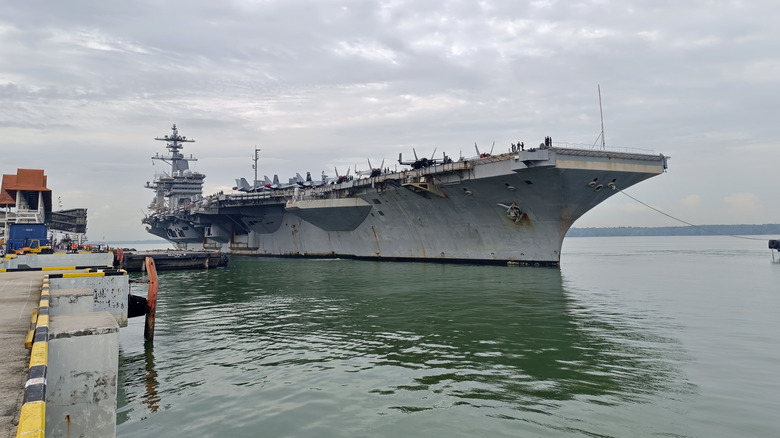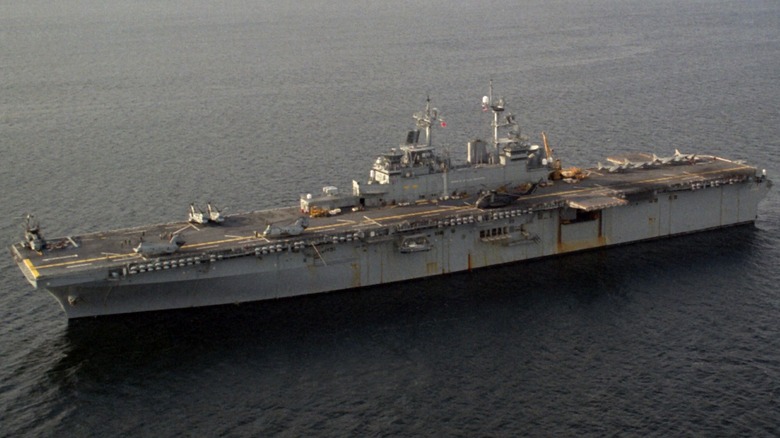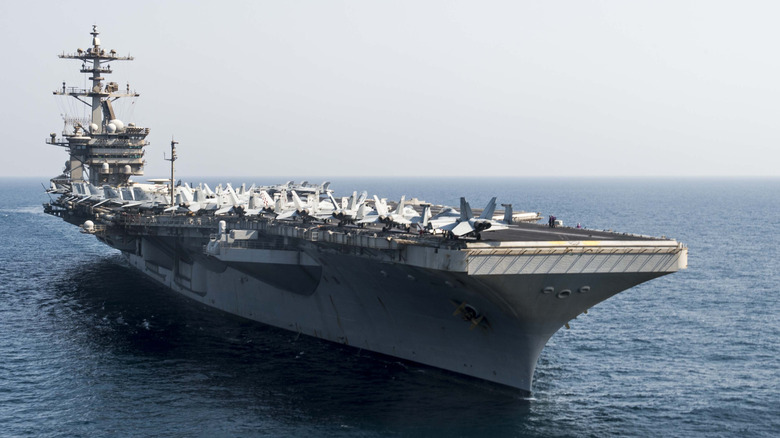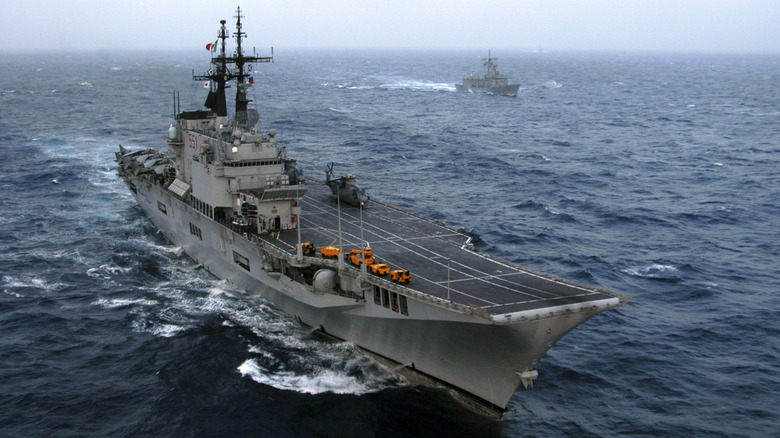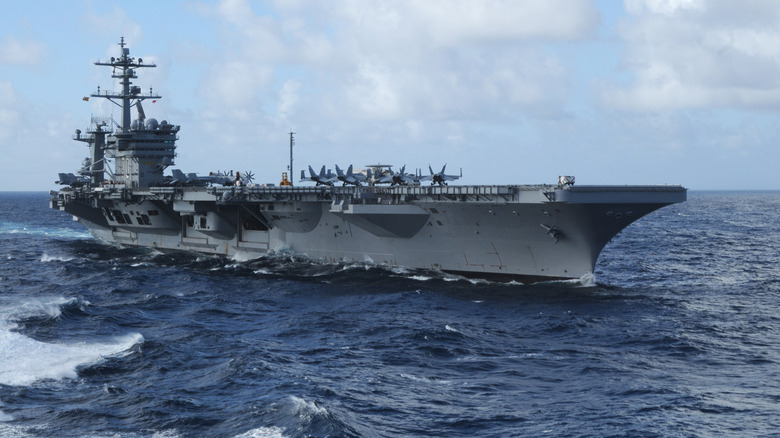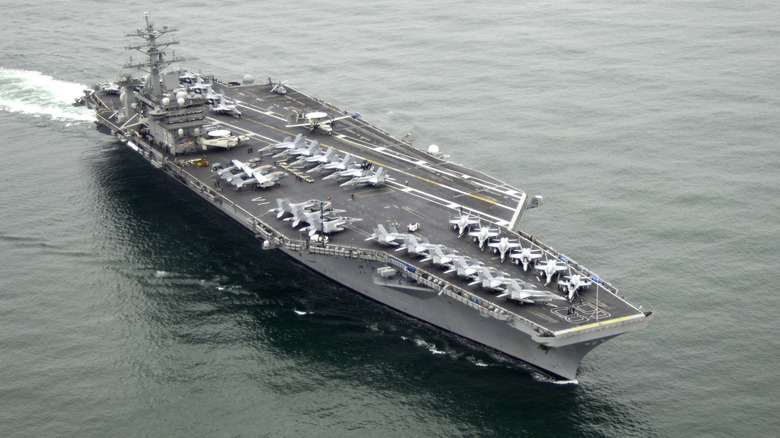14 Of The Oldest Aircraft Carriers Still In Service
The backbone of a powerful navy is the almighty aircraft carrier. While battleships and destroyers might be armed with fancy cannons and missile launchers, aircraft carriers carry deadly fighter jets that dart across the ocean faster than any seafaring vessel, capable of striking targets from many miles away. In World War II, American aircraft carriers proved invaluable in getting the upper hand over the Imperial Japanese Navy, which was more heavily invested in powerful destroyers and didn't foresee just how important aircraft carriers would be in the Pacific Theater.
Today, not including helicopter carriers (which are an entirely different class of ship), there are 22 aircraft carriers in service around the world, with a full half of them operated by the United States, which runs the largest military force in the world by a huge margin. Let's take a look at some of the oldest aircraft carriers still in service today. As you might expect, most of them are American ships, but there are a couple of surprises in there for those interested in foreign militaries.
Liaoning
The Chinese military has the most aircraft carriers after the United States, but that's not saying much. For comparison, the USA has 11 carriers, and China operates three. Their oldest is the Liaoning. Originally built by the Soviet Union in the mid-1980s and rechristened Varyag in 1990, the ship fell into disrepair after the fall of Communism. In the late '90s, Ukraine sold the ship to China, which received little more than the bare skeleton of an aircraft carrier, since its engines, weapons, and all other usable equipment were entirely stripped away.
Thus began a lengthy refurbishment process. The ship arrived in China in 2002 but was not commissioned into the Chinese Navy until 2012. Even then, it wasn't declared fully combat-ready until 2016. On the surface, the Liaoning might seem like a modern vessel, but at its core, the carrier is firmly rooted in the 1980s. Since then, China has built its own aircraft carriers and will continue to do so as global tensions rise.
USS Ronald Reagan
The USS Ronald Reagan began construction in 1998 but wouldn't be commissioned until 2003. President Reagan was still alive when the ship was christened. However, due to his advanced Alzheimer's disease and associated dementia, he did not attend the ceremony. His wife, Nancy Reagan, was there to see the ship off on its maiden voyage.
The USS Ronald Reagan was the first aircraft carrier to be named after a still-living POTUS. Reagan passed away in 2004, 11 months after the ship was launched, but the aircraft carrier that bears his name is still in service, although it's currently in dry dock at Naval Base Kitsap, undergoing a 17-month maintenance period that is expected to last into 2026, after which the ship will return to active duty.
USS Harry S Truman
On February 1, 2025, 27 F-18 Super Hornet jet fighters launched a massive airstrike on ISIS forces in Somalia. Over the course of two minutes, 124,000 pounds of explosives were dropped from 16 jets, killing 14 ISIS members and presumably turning their base into little more than a pile of ash. The strike, the largest of its kind in U.S. Navy history, was launched from the aircraft carrier USS Harry S Truman. The ship was originally developed as the USS United States, but the name was changed to honor the country's 33rd president, Harry S. Truman.
Despite distinguishing itself in this action, the HST also made headlines for the wrong reasons. Remember the unfortunate spate of F-18s falling off aircraft carriers? That was the HST. In April and May of 2025, F-18s accidentally rolled off the side of the carrier, falling into the ocean. Considering a single F-18 Super Hornet costs well over $50 million, that's a costly accident to happen even once, let alone twice.
USS John C. Stennis
Senator John C. Stennis of Mississippi left behind a complex legacy. He famously supported "Dixiecrat" politics in the 1940s and onward, promoting racial segregation and opposing the Civil Rights Act. However, he ultimately came around, and by the 1980s even went so far as to vote for extending the Voting Rights Act and voting against Ronald Reagan's nomination of Robert Bork for the Supreme Court, which was a whole other saga unto itself. The point is, like most people, Stennis was a multi-faceted human who, as the saying goes, "contained multitudes." In any case, it didn't stop Reagan from approving the naming of an aircraft carrier after the man in 1988, the final year of his presidency.
While still part of the Naval fleet, the USS John C. Stennis is currently out of action. As of this writing, the ship is undergoing a complete overhaul that began in 2021 and, following delays, is currently expected to take five years to complete. It's a natural part of the life cycle of a nuclear-powered ship of this size, which is perhaps why the U.S. Navy fields multiple carriers, ensuring that a single loss doesn't significantly weaken overall strike power.
USS Essex
The USS Essex is not to be confused with the WWII-era aircraft carrier of the same name. That Essex survived through WWII and the Korean War before being decommissioned in 1969. The Essex we're talking about was ordered in 1986 and commissioned in 1992. Since then, the Essex distinguished itself through its deployments on missions of mercy following events such as the 2010 Super Typhoon Juan in the Philippines and the 2011 Tōhoku earthquake and tsunami. As a result of these efforts, in the Philippines specifically, the ship's crew was awarded the Humanitarian Service Medal.
In 2012, the Essex was involved in an accident where it collided with the USNS Yukon. While nobody was hurt in the incident, it was an embarrassing moment for the United States military. Captain Chuck Litchfield was relieved of command, and several other officers were held responsible and reprimanded.
USS George Washington
There has been no shortage of ships named "George Washington." After all, as the father of the United States and a general during the American Revolutionary War, it is fitting that ships and other military icons bear his name. First, there was an 18th-century schooner in the Continental Navy, later a WWI-era transport ship, and then a Cold War submarine, among others. However, the George Washington we're talking about today is the Nimitz-class nuclear-powered aircraft carrier.
The ship was ordered in 1982 and was commissioned in 1992, a full decade later. In the wake of 9/11, the George Washington was deployed to New York City, ostensibly for protection in the event of a follow-up attack, but it was more of a symbolic gesture to provide peace of mind to New Yorkers.
In 2008, the ship was heavily damaged by an onboard fire, injuring dozens of sailors, though there were thankfully no fatalities. Nevertheless, the ship was out of action, with repairs costing around $70 million. Captain David C. Dykhoff was removed from command, as was Executive Officer Captain David M. Dober. Several other sailors were punished for the fire, which was started by, of all things, unauthorized cigarette smoking.
Admiral Flota Sovetskogo Soyuza Kuznetsov
Now we arrive at the only Russian entry on this list and, indeed, the only Russian aircraft carrier. The Admiral Flota Sovetskogo Soyuza Kuznetsov was named after Soviet admiral Nikolai Kuznetsov, who passed away in 1974, seven years before the ship was ordered. Upon joining the fleet in 1991 (just in time for the fall of the Soviet Union), the ship became the flagship of the Russian Navy until 2017, when it was taken out of service to be overhauled and modernized. The process was expected to take several years.
However, in 2022, Russia embarked on a "special military operation," better known as the full-scale invasion of neighboring Ukraine. Russia anticipated the war would last for several days; three-and-a-half years later, Ukraine has not given in. In 2024, all sailors assigned to the Kuznetsov were reassigned to Ukraine, and the ship's refit was abandoned. As a result, the Russian Navy is enfeebled and without a flagship.
USS Abraham Lincoln
In 2024, Houthi forces in Yemen launched an attack on several American ships, including the USS Abraham Lincoln. Houthi social media reported that the group had damaged, or possibly even sunk, the Abraham Lincoln. This would make the Abraham Lincoln the first American aircraft carrier to be destroyed since the Battle of Iwo Jima in 1945.
The only problem with this narrative is that the Houthis made it up. While an attack was lobbed at the Lincoln, all of the missiles were shot down. However, that didn't stop the Houthi social media team from claiming otherwise to sow discord and create chaos.
For those looking for a close-up look at the USS Abraham Lincoln, a ship which began construction in 1984, the carrier was used as a filming location for "Top Gun: Maverick," which grossed nearly $1.5 billion at the global box office in the Summer of 2022.
USS Wasp
The USS Wasp comes from a long line of ships with that name, dating all the way back to a merchant schooner employed by the Continental Navy in 1775, before the United States was even a country. An aircraft carrier by that name was sunk during World War II, after which another aircraft carrier named Wasp was launched in 1943 before retiring in 1972. The latest USS Wasp, which began construction in 1985 before earning its commission in 1989, is an amphibious assault ship built to carry both air and seacraft to enable multipronged assaults on enemy positions.
The USS Wasp was the first carrier from which Osprey VTOL aircraft were launched. This occurred in 2007, during Operation Iraqi Freedom. That same year, the ship went to Nicaragua to provide humanitarian aid to victims of Hurricane Felix, which caused over 130 fatalities and hundreds of millions of dollars in property damage. While aircraft carriers are commonly seen as weapons of war, events like the aftermath of Hurricane Felix show that they can be essential on humanitarian missions, too.
USS Theodore Roosevelt
In 1980, the order came down to build the USS Theodore Roosevelt, and the ship officially joined the Navy in 1986. The ship played a key role in Operation Desert Shield, Operation Enduring Freedom, and Operation Iraqi Freedom. Despite this distinct history of service, the USS Theodore Roosevelt is even more famous for its role during the Coronavirus pandemic and its role in bringing down Secretary of the Navy Thomas Modly.
During the early days of the pandemic, in March 2020, several sailors aboard the USS Theodore Roosevelt came down with the virus. By the end of the month, 100 crew members were sick. Concerned with the safety of the men under his command, Captain Brett Crozier sent an email to 10 people, three admirals, and seven captains, asking for assistance with evacuating the ship, which was not built with social distancing in mind. The letter was somehow leaked to the press, at which point Modly had Crozier sacked.
This controversial decision, as well as Modly's flippant dismissal of criticism over his actions, led to Modly resigning from his position in disgrace, a symbol of the Trump administration's poor reaction during the early days of the pandemic. As for Captain Crozier, he didn't regain his commission aboard the USS Theodore Roosevelt, but after being reassigned to a job at the Naval Air Forces in San Diego, he retired from the Navy in 2022.
Giuseppe Garibaldi
The final aircraft carrier on this list that doesn't belong to the United States is the Giuseppe Garibaldi. The name probably gave it away, but this is an Italian ship. Construction began in 1981, and the ship was officially commissioned in 1985. The ship served in the Kosovo War, as well as part of the coalition forces that went into Afghanistan during Operation Enduring Freedom following the 9/11 terror attacks. In 2009, Italy replaced Giuseppe Garibaldi with a new flagship, the Cavour, but it remained in service for another fifteen years.
The fate of the Giuseppe Garibaldi is currently in a state of limbo. The Italian Navy decommissioned the ship in 2024, effectively ending its career, or so it seemed at the time. In 2025, Indonesia expressed interest in purchasing the Giuseppe Garibaldi, as well as its complement of Harrier jets. As of this writing, the sale is still pending, but Indonesia still seems eager to add the mighty ship to its navy.
USS Carl Vinson
For those who don't recognize his name, Carl Vinson was an American congressman who championed bills like the Naval Act of 1938 and the 1940 Two-Ocean Navy Act, both of which bolstered the United States Navy in the lead-up to America's entry into World War II. Given how American success in the Pacific theater was owed to its fleet of aircraft carriers, it's fair to say that Carl Vinson changed the course of history with his legislation.
The USS Carl Vinson was ordered in 1974. At age 96, Carl Vinson attended the ship's launch in 1980, one year before he died in 1981. The ship was the first aircraft carrier to launch jets during Operation Enduring Freedom, and it proved instrumental in providing relief in the aftermath of the 2010 Haiti earthquake. Most famously, and in a bit of a full-circle moment from Enduring Freedom, the Carl Vinson was the ship that carried Osama Bin Laden's body and cast it into the sea.
USS Dwight D. Eisenhower
The USS Dwight D Eisenhower dates back to the 1970s, with construction beginning in 1970 before joining the fleet in 1977. Like the USS Abraham Lincoln before it, the Houthis in Yemen claimed to damage the USS Dwight D. Eisenhower in an attack, using fake images to bolster their misinformation. Of course, the USS Dwight D. Eisenhower was unharmed in reality.
Originally, the ship was going to be called simply USS Eisenhower, but the rest of the 34th President's name was added. That may seem odd, but in hindsight, such specificity can avoid political maneuvering. In 1918, Fort Bragg was named after Confederate General Braxton Bragg. Over a century later, in 2023, the installation was renamed Fort Liberty. However, in 2025, the Trump administration took steps to rename it to Fort Bragg, claiming that it was no longer named after Braxton Bragg, but for Silver Star winner Roland L. Bragg, a WWII paratrooper.
USS Nimitz
The oldest aircraft carrier still in service is the USS Nimitz, named after WWII Fleet Admiral Chester W. Nimitz. As the oldest carrier, it's also, by default, the oldest nuclear-powered aircraft carrier still in service, though the first-ever nuclear-powered aircraft carrier was the USS Enterprise, which was decommissioned in 2017.
The USS Nimitz is near the end of its life. Ships of this class have a shelf life of around 50 years, and 2025 marks the 50th anniversary of Nimitz's commissioning. As of this writing, the Nimitz is scheduled to retire in 2026, when it will report to Norfolk Naval Station in Virginia to begin the years-long decommissioning process.
The new USS John F. Kennedy, a Gerald R. Ford-class carrier, will replace the Nimitz. Other Nimitz-class carriers near the end of their tenure will also be replaced by Ford-class carriers under construction, including a new Enterprise.
